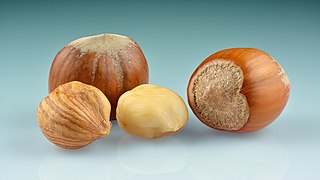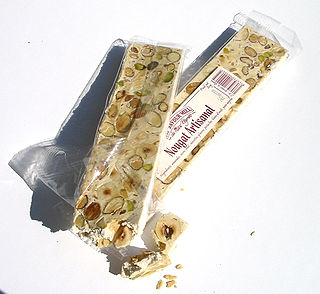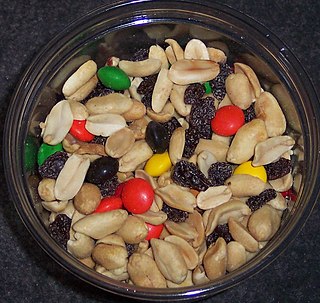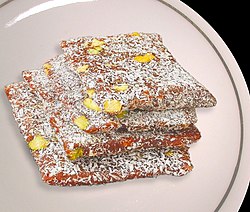
Turkish cuisine is the cuisine of Turkey and the Turkish diaspora. Although the cuisine took its current rich form after numerous cultural interactions throughout centuries, it should not be confused with other cuisines such as Ottoman cuisine or Seljuk cuisine. Turkish cuisine with traditional Turkic elements such as yogurt, ayran, kaymak, exerts and gains influences to and from Mediterranean, Balkan, Middle Eastern, Central Asian and Eastern European cuisines.

Halva is a type of confectionery originating from Persia and widely spread throughout the Middle East and South Asia. The name is used for a broad variety of recipes, generally a thick paste made from flour, butter, liquid oil, saffron, rosewater, milk, turmeric powder, and sweetened with sugar.

Pesto or more fully pesto alla genovese is a paste made of crushed garlic, pine nuts, salt, basil leaves, grated cheese such as Parmesan or pecorino sardo, and olive oil. It originated in the Italian city of Genoa, and is used to dress pasta and sometimes soups.

The hazelnut is the fruit of the hazel tree and therefore includes any of the nuts deriving from species of the genus Corylus, especially the nuts of the species Corylus avellana. They are also known as cobnuts or filberts according to species.

Nougat is a family of confections made with sugar or honey, roasted nuts, whipped egg whites, and sometimes chopped candied fruit. The consistency of nougat is chewy, and it is used in a variety of candy bars and chocolates. The word nougat comes from Occitan pan nogat, seemingly from Latin panis nucatus 'nut bread'.

Carrot cake is cake that contains carrots mixed into the batter.

A garnish is an item or substance used as a decoration or embellishment accompanying a prepared food dish or drink. In many cases, it may give added or contrasting flavor. Some garnishes are selected mainly to augment the visual impact of the plate, while others are selected specifically for the flavor they may impart. This is in contrast to a condiment, a prepared sauce added to another food item primarily for its flavor. A food item which is served with garnish may be described as being garni, the French term for "garnished."
Mithai (sweets) are the confectionery and desserts of the Indian subcontinent. Thousands of dedicated shops in India, Bangladesh, Nepal, Pakistan and Sri Lanka sell nothing but sweets.

Maamoul is a filled butter cookie made with semolina flour. It is popular throughout the Arab world. The filling can be made with dried fruits like figs, dates, or nuts such as pistachios or walnuts, and occasionally almonds.

Knafeh is a traditional Arabic dessert, made with spun pastry called kataifi, soaked in a sweet, sugar-based syrup called attar, and typically layered with cheese, or with other ingredients such as clotted cream, pistachio or nuts, depending on the region. It is popular in the Middle East.

Qatayef, katayef, or qata'if, is an Arabic dessert. It is a type of sweet dumpling filled with cream or nuts, or a folded pancake, similar to a Scottish crumpet.

Baklava is a layered dessert made of filo pastry sheets, filled with chopped nuts, and sweetened with syrup or honey.

Gajar ka halwa, also known as gajorer halua, gajrela, gajar pak, and carrot halwa is a carrot-based sweet dessert pudding made by placing grated carrots in a pot containing a specific amount of water, milk and sugar, cardamom and then cooking while stirring regularly. It is often served with a garnish of almonds and pistachios. The nuts and other items used are first sautéed in ghee, a type of clarified butter from the Indian subcontinent.

Supangle or sup is a type of Turkish chocolate pudding. Its bottom layer includes pieces of cake and it is often garnished with pistachio or coconut, and chocolate chips.

A snack is a small portion of food generally eaten between meals. A snack is often less than 200 calories, but this can vary. Snacks come in a variety of forms including packaged snack foods and other processed foods, as well as items made from fresh ingredients at home.
Kaysefe is a Turkish dessert made of dried fruits and melted butter. It is a regional specialty of Erzurum. Different fruits may be used including dried apricots or mulberries. First the dried fruit is boiled in water with sugar. Butter is spooned over the boiled fruit and the dessert is garnished with chopped or ground walnuts, pistachios or hazelnuts.
Şıllık is a Turkish dessert crepe that is a specialty of the southeastern Urfa province. It is a thin dough made of milk and flour, similar to a crepe, filled with ground walnuts and topped with simple syrup and chopped pistachio. Some versions of the filling may include a mix of walnut and pistachio. Butter or Turkish grape molasses may optionally be added to the simple syrup sauce. Traditionally, lamb tail fat was used to fry the crepes. In Turkish the word şıllık means slut or hussy, so some women in the conservative province of Urfa are not comfortable ordering the dessert by name, preferring instead to allow a male relative to order it for them or simply asking for "that dessert".














